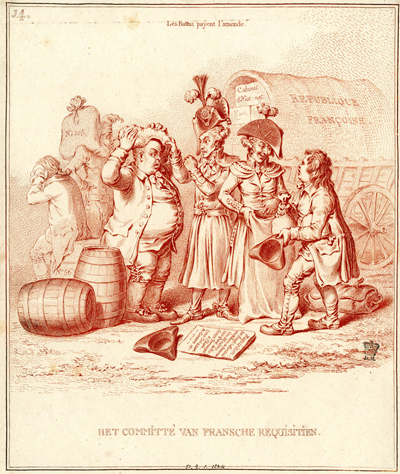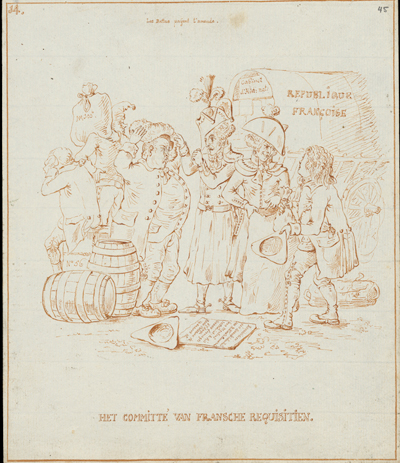Het Committé van Fransche Requisitien
This is the fourteenth plate of a twenty plate series, Hollandia Regenerata, etched by Gillray based on drawings by the Swiss soldier, painter, and caricaturist, David Hess. For more about David Hess, and the political and artistic context of the series satirizing the newly-created and French-supported Batavian Republic, see my Introduction.
The Dutch title can be translated as "The Committee for French Requisitions." According to Joost Rosendaal whose "Nawoord" to the wonderful 2007 facsimile edition of Hollandia Regenerata is essential reading for anyone interested in the series, the Committee referred to in the title is fictional, an invention of Hess for consistency with other plates in the series which were based on real Batavian committees. But though the Committee is imaginary, the requisitions, themselves, were all too real.

Het
Committé van Fransche Requisitien
[1796?]
© Trustees of the British Museum
Occupying armies, even temporary ones, are not typically careful about ownership. If they need it, they take it. That was true of the Prussian and English armies that effectively pillaged parts of Holland as they retreated before the French in 1794. And it was also true of the French generals after the proclamation of the Batavian Republic in 1795. According to Simon Schama,
On January 25 the sheriff of the village of Nijmegen had complained to the representatives that during the two months his hamlet had been occupied by Macdonald's troops they had ransacked the neighborhood, seized crops as they stood in the granaries; carried off cattle and even dairy cows for meat rations without pausing to settle, even in worthless assignats. Jourdan's companies had refrained from pillaging, but had left their billets removing with them every stick of furniture, 'including the beds.'
But after the Treaty of the Hague signed in May 1795, this systematic looting was institutionalized. By virtue of the Treaty, the Dutch were required to provide support for 25000 French troups. Not surprisingly the subtitle of the print is: "Les battus payent l'amende" (The beaten pay the fine.)
In Het Committé van Fransche Requisitien we see two French officers filling their supply wagon with the items that have been requisitioned. The list lying on the ground before the French General (identified in the "Explanation" as General Lefebure) includes:
- 500 Boeufs hollandais
- 100 Millions de Numerair[e]
- 600 Moutons
- 1000 Quint: de Ris.
- 60000 Fromages
- d'Edam
- 3000 Toneaux de Genevre etc.
As Ralph Fell describes in his nearly contemporaneous Tour Through the Batavian Republic
. . . all persons in possession of any of the articles wanted, were ordered to deliver them up to commissioners appointed for that purpose; and the provincial administrations were directed to furnish with all possible dispatch their several quota towards defraying the expence of the requisition. (306)
Workmen on the left can be seen loading numbered bags and boxes of goods. On the right another French soldier is directing a Dutch citizen to add his bag to the large sack he is holding. In the center, the General seems about to requisition the very wig from the head of the recalcitrant Dutchman.
As with all the plates in the series, the corresponding page to the image contains one or more appropriately ironic Biblical quotations in Dutch and English and a satiric "Explanation" in French. The Biblical quotation would certainly have reflected the feeling of many of the Dutch citizens.
Jeremiah, xiii. 19. "Judah shall be wholly carried away."
The heavily ironic "Explanation." suggests that for the Batavians, the price of freedom is a return to poverty.
La plus indigeante liberté vaut mieux que le plus riche esclavage. Les Bataves donnent volontiers ces perfides tresors à leurs fidêles alliés, qui leur ont procuré l'incalculable avantage de retourner à leur ancienne médiocrité, et à la besace de leurs ayeuls. Note. L'idée de ce dessein tire son origine d'une anectodte véritable. Le General Français Léfebure, dans la chaleur de la conversation, enleva ainsi la peruque à un municipal d'Arnheim, qui faisait d'éternelles objections contre les requisitions du General.
Here is my free English translation.
The poorest freedom is better than the richest slavery. The Batavians willingly give their wealth to the faithful French allies, who have given them the incalculable advantage of returning them and their wallets to the mediocre state of their grandparents.
Note. The idea for this design is based upon a true story. General Lefebure, in the heat of conversation, removed the wig of an official from Arnheim, who was making strenuous objections to the General's demands.
The episode with General Lefebure is not the only detail in the print based on fact. In the wagon, we can see a box labeled "Cabinet d'Hist: nat." This almost certainly refers to the "cabinet of natural history and museum of rarities"(89) mentioned by Ralph Fell which had belonged to the Prince of Orange and was kept at The Hague. It was now, according to Fell, "removed to Paris; and as the influence of party operates, its loss is regarded as a weighty misfortune, or a trifle unworthy of notice." Like other Dutch art works and museum pieces which made their way to the French capital, this was not on the list of requisitioned items in support of French troops.

Het Committé
van Fransche Requisitien
[1796?]
© Zentralbibliothek Zürich
Like most of the plates of Hollandia Regenerata, Gillray follows the Hess's drawing closely. The basic disposition of the figures and meaning of the print both derive from Hess, but Gillray has sharpened every line and, with a wonderful use of shading, given a depth and solidity to the background, foreground, and figures (especially their clothes) that is missing in the original Hess drawing. In this case, he has also improved the contour of the fat man's belly, corrected his awkwardly drawn right arm, and added fingers from the man's left hand holding on to his wig. The expression of General Lefebure is also made more threatening.
Sources and Reading
- Commentary from the British Museum on Het Committé van Fransche Requisitien.
- "Batavian Republic," Wikipedia
- Treaty of The Hague (1795) Wikipedia
- "David Hess (painter)," Wikipedia
- "David Hess," SIKART Dictionary
- David Hess, Hollandia Regenerata (1797), Nawoord by Joost Rosendahl, Uitgeverij Vantilt, 2007
- Ralph Fell, A Tour Through the Batavian Republic
- Simon Schama, Patriots and Liberators: Revolution in the Netherlands 1780 - 1813, London, 1992
Comments & Corrections
NOTE: Comments and/or corrections are always appreciated. To make that easier, I have included a form below that you can use. I promise never to share any of the info provided without your express permission.